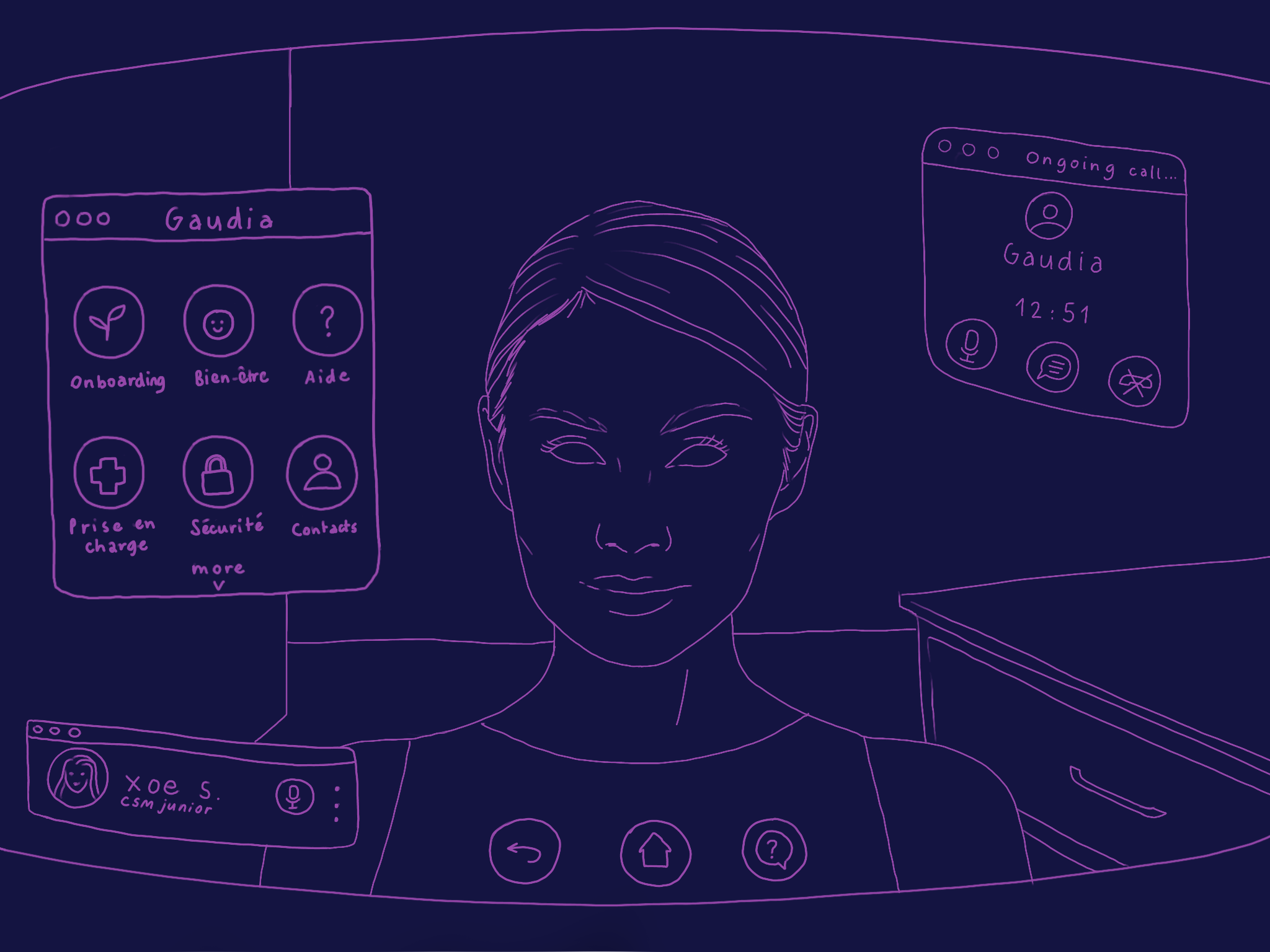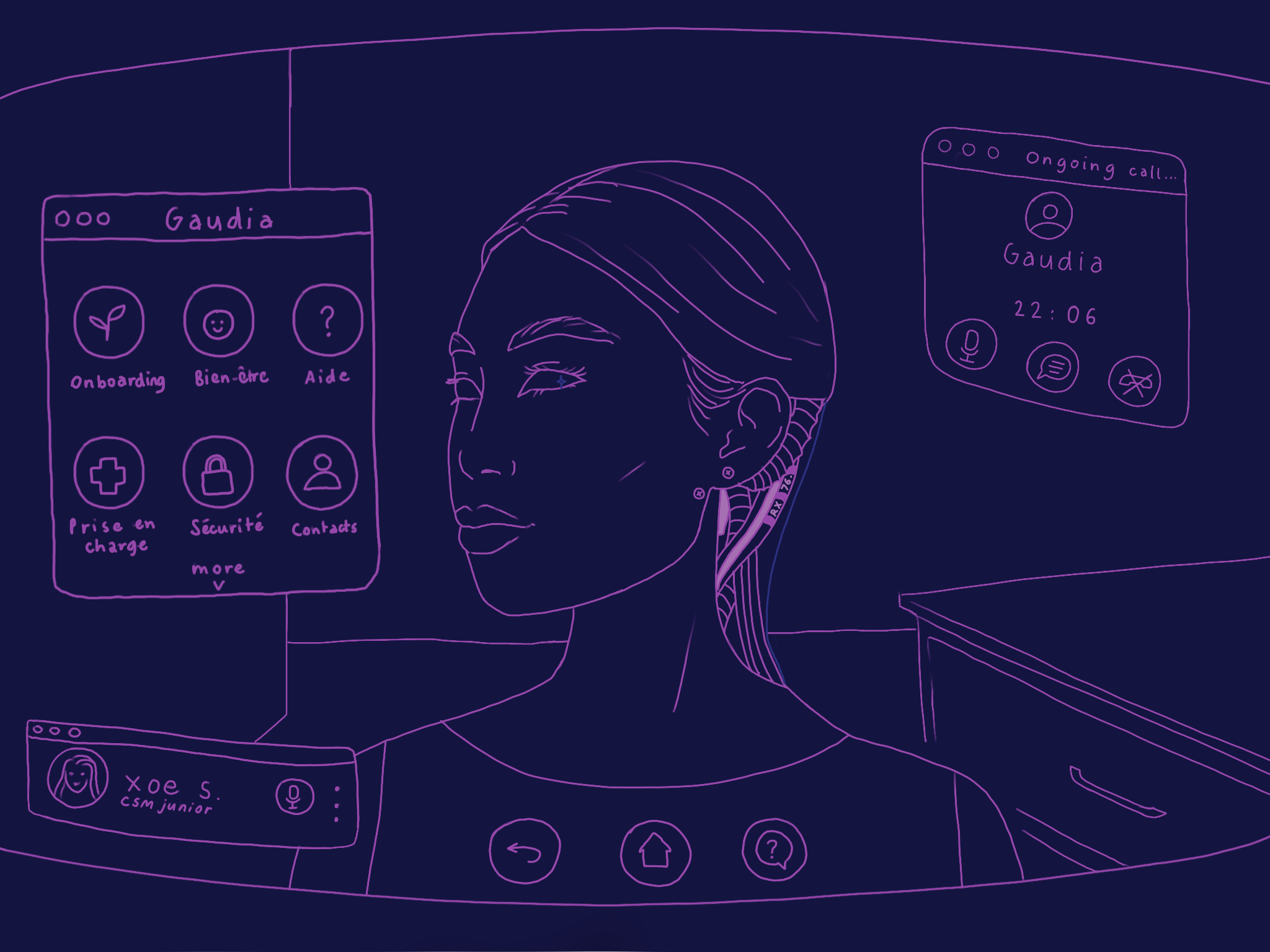Somewhere in the world, at a certain date you don’t need to know, we have located advanced technology that allows us to get inside the daily lives of employees. This fantastic journey through the experiences of different collaborators will take you to the edge of the Future of Work and allow you to gain insight into the challenges of business transformation. Today in our odyssey, discover the daily life of Xoe…
“Hello Xoe, welcome to Coorpacademy! I am Onboard, your virtual assistant who will accompany you during your onboarding for the position of Junior Customer Success Manager. I see from your employee profile that you have never visited our physical premises before. I hope you will soon, but first let me guide you through our meta-offices!”
A loading icon appears on my left. I readjust my helmet.

Once properly positioned, Onboard’s voice resumes:
“The meta-desk is a virtual workspace where the whole team can meet, even from a distance. As you can see, the 3D reconstruction of our premises allows you to discover your workspace as if you were there! If you would like a guided tour, click on…”
I decide to turn off the tutorial mode. I’m pretty well used to virtual reality, I even remember taking my University exams remotely during the heat wave of 2042. I move around the virtual offices and discover bright and very ergonomic premises, with a fully equipped kitchen, from the permaculture worktop to the compost bin integrated into the cooker! In the open-space, the work spaces are both shared, but there are also small cubicles that allow everyone to isolate themselves if necessary, which I like because, being a bit anxious at times, I like to be able to be alone in a quiet place.

A new notification appears.
“To reserve your workstation in advance, remember to download the “Coorpers Portal” application, which will enable you to carry out all your procedures relating to your workplace, contract and other administrative requests. I notice that the workspaces are not assigned, and that there are lockers connected to store everyone’s personal belongings. I understand that the Coorpers Portal application will allow me to book an office or a meeting room, to rent a connected locker for free or to make absence requests.
As I finish the visit, Onboard’s voice says: “How did your first steps in our offices go?”, a screen appears asking me to rate my visit between 1 and 5 and as I fill in my score, the surprisingly human voice of this artificial intelligence tells me: “For your information, all the data collected through the questions asked are anonymised and allow us to continuously improve the employee experience! To continue your onboarding, why don’t you meet the teams?”
I confirm and am propelled into a colourful and welcoming meeting room where the video testimonials of several employees are displayed on my screen. I can scroll through the videos and choose to start one. This is how I find out about each person’s role. At the end of each story, Onboard asks me if I have any questions, and if so, sends a message directly to the person concerned to arrange a meeting to discuss my questions further.
“It’s time for you to meet your manager! A video call is scheduled for 10 minutes with Clément M., Senior Customer Success Manager”, says Onboard, which I decide to mute in the settings of my virtual headset. I prefer subtitles, and it’s quite fun to be able to change the language in which Onboard speaks to me. Indeed, I have the possibility to modify the parameters to inform the language in which Onboard is configured. This could allow me to revise my French!
The interview with Clément went very well. After introducing me to the team and the tasks of the job, he moves on to a more personal part of the interview. I can tell him that the pronoun I use is the pronoun she, that I am anxious by nature and that in my job I get great satisfaction from having a real impact on society.
“Great, so you’ve got a rather Impact-oriented mode of reporting at work. I will send you a notification to fill in your personal information in Coorpers Portal, your pronoun used, your passions, your work aspirations, etc. The artificial intelligence of this application allows us to identify the projects that correspond to you and also the best way to communicate with each collaborator!
Speaking of apps, we also have a version for our customer accounts. As a central tool for our team, the Coorp & You application allows us to centralise data on our relationship with our clients, to get to know them better as individuals, but also as a company. They fill in their issues, priority levels, upcoming projects, areas for improvement, etc. This tool is very complete, you will have to learn how to use it, because it will allow you to know your client by heart, to better accompany them. I’ve already told Onboard to download these applications so that you can take a look at them today to familiarise yourself and note down if you have any questions!”
Once the interview is over, I watch the progress of the Coorp & Vous application loading on the virtual headset. I reflect on this onboarding and think of my parents, who used to talk about how they had seen companies transform. This world of tomorrow, as they called it, they participated in its construction and today, it is the world in which I will have to prove myself.
Conclusion
In 2050, the digitalisation of companies will have changed the way we are organised at all levels.
As a tool to facilitate and automate certain processes, digital technology will be able to replace the mentor during onboarding and save time for managers
The workspace will also be rethought to create a healthy, environmentally friendly and flexible environment: offices will no longer be assigned to an employee but will be workspaces that employees can reserve for the day, the kitchen will be equipped to allow employees to find the same comfort as at home, and the company will be able to rethink its workspaces by involving issues of biodiversity and environmental friendliness.
Finally, intergenerational relations and issues of taking into account the personality of employees will be paramount. In addition, the data that managers will be able to collect thanks to the digitalisation of processes will enable them to get to know each employee better, to individualise their management style and thus engage their employees.





 Emojis have become indispensable for punctuating a sentence, accentuating an emotion or slipping an innuendo into a digital conversation. Indeed, some companies or associations are taking advantage of emojis for their advertising campaigns: Domino’s Pizza recently launched a Twitter campaign where people from all over the world could tweet the company with the Pizza Emoji to order one. Associations have also understood the effectiveness that these emojis can bring to their digital communication, such as the nature conservation organisation WWF, which launched an awareness 2.0 campaign using Emojis through the hashtag #EndangeredEmoji in 2016. Thus, it is clear that emojis are no longer just a private conversation and are no longer considered a decorative or innocuous element; they represent a new and improved form of language that has its roots in digital, breaking down language barriers for brands.
Emojis have become indispensable for punctuating a sentence, accentuating an emotion or slipping an innuendo into a digital conversation. Indeed, some companies or associations are taking advantage of emojis for their advertising campaigns: Domino’s Pizza recently launched a Twitter campaign where people from all over the world could tweet the company with the Pizza Emoji to order one. Associations have also understood the effectiveness that these emojis can bring to their digital communication, such as the nature conservation organisation WWF, which launched an awareness 2.0 campaign using Emojis through the hashtag #EndangeredEmoji in 2016. Thus, it is clear that emojis are no longer just a private conversation and are no longer considered a decorative or innocuous element; they represent a new and improved form of language that has its roots in digital, breaking down language barriers for brands.